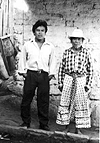|
|
|
 |
|
| . |
|
| . | |
 |
|
| . | |
|
LINKS TO SECTION PAGES |
|
| .. | |
| Above: A group of Tz'utuhil artists wait to enter a reception for the book, Arte Naif Guatemala, published by UNESCO about Guatemala's naive Mayan artists. Nobel Peace prize winner Rigoberta Menchú and Frances president Jacques Chirac hosted the artists. [r. to l.] San Pedro artists Rafael Enrique Gonzalez M., Pedro Rafael Gonzalez Chavajay, Matias Gonzalez Chavajay, Mariano Gonzalez Chavajay, Domingo Garcia Criado and Emilio Gonzalez Morales. At left in the short white pants is Santiago Atitlan artist Miguel Chavez who stands in front of San Juan artists, the two men in modern dress, Antonio Coche and Felipe Ujpan. | |
| . | |
| CLICK ON IMAGE FOR LARGER SIZE |
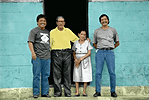 Three
generations of artists stand together in front of the house of San Pedro
la Laguna's first painter Rafael Gonzalez y Gonzalez [in
yellow]. His grandson Pedro Rafael Gonzalez Chavajay stands on the
left and his son, Pedro Rafael's uncle, stands on the right. painters, visits his grandfather Rafael
Gonzalez y Gonzalez, the first Tz'utuhil painter. Rafael moved from San
Pedro la Laguna to Chicacao on the coastal side of the San Pedro Volcano where he lived with his wife Candida
until his death in 1996. Rafael Angel is one of two sons who are
painters and Pedro Rafael is the first of four grandchildren who are
painters. Pedro Rafael's father moved back to San Pedro before Pedro
Rafael was born. Three
generations of artists stand together in front of the house of San Pedro
la Laguna's first painter Rafael Gonzalez y Gonzalez [in
yellow]. His grandson Pedro Rafael Gonzalez Chavajay stands on the
left and his son, Pedro Rafael's uncle, stands on the right. painters, visits his grandfather Rafael
Gonzalez y Gonzalez, the first Tz'utuhil painter. Rafael moved from San
Pedro la Laguna to Chicacao on the coastal side of the San Pedro Volcano where he lived with his wife Candida
until his death in 1996. Rafael Angel is one of two sons who are
painters and Pedro Rafael is the first of four grandchildren who are
painters. Pedro Rafael's father moved back to San Pedro before Pedro
Rafael was born. |
| . | |
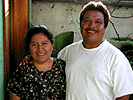 Pedro
Rafael began painting when his grandfather gave him a set of watercolors.
He was the first of many Pedranos to follow in Rafael's footsteps. Pedro
Rafael and his wife, Agudelina (Audi) stand outside the door to her
restaurant, Café Arte, in San Pedro. Pedro
Rafael began painting when his grandfather gave him a set of watercolors.
He was the first of many Pedranos to follow in Rafael's footsteps. Pedro
Rafael and his wife, Agudelina (Audi) stand outside the door to her
restaurant, Café Arte, in San Pedro. |
|
| . | |
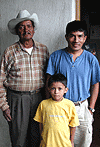 Mario
Gonzalez Chavajay began painting in about 1987. He did not learn from his
older brother Pedro Rafael, instead striking out on his own. Their styles
of painting differ significantly. Here we see Mario [blue shirt] with his
father Herlindo and his son. Herlindo was the oldest son of first
Tz'utuhil Maya artist Rafael Gonzalez y Gonzalez pictured above. Mario
Gonzalez Chavajay began painting in about 1987. He did not learn from his
older brother Pedro Rafael, instead striking out on his own. Their styles
of painting differ significantly. Here we see Mario [blue shirt] with his
father Herlindo and his son. Herlindo was the oldest son of first
Tz'utuhil Maya artist Rafael Gonzalez y Gonzalez pictured above. |
|
| . | |
 Rafael
Enrique Gonzalez Mendez allows me to interrupt a conversation with his
father-in-law to take their photograph. Rafael is one of four grandsons of
Rafael Gonzalez. He has been painting since Rafael
Enrique Gonzalez Mendez allows me to interrupt a conversation with his
father-in-law to take their photograph. Rafael is one of four grandsons of
Rafael Gonzalez. He has been painting since about 1987. Although he is highly skilled as a painter, recently he has
painted less. A lagging economy due to the World Trade Center attacks and
Santiago Atitlan galleries who would rather pay the new younger artists
for quantity rather than quality have contributed to the situation.
about 1987. Although he is highly skilled as a painter, recently he has
painted less. A lagging economy due to the World Trade Center attacks and
Santiago Atitlan galleries who would rather pay the new younger artists
for quantity rather than quality have contributed to the situation. |
|
| . | |
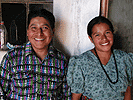 Jose
Antonio Gonzalez Chavajay, named for his Uncle who is an painter, is the
youngest of three brothers who are artists. Jose Antonio learned from his
older brother Mario. Not surprisingly his style of painting closely
resembles that of Mario with distinctive differences. He has been painting
since about 1998, and sells most of his paintings through the galleries of
brothers Salvador and Jose Reanda in Santiago Atitlán. Jose
Antonio Gonzalez Chavajay, named for his Uncle who is an painter, is the
youngest of three brothers who are artists. Jose Antonio learned from his
older brother Mario. Not surprisingly his style of painting closely
resembles that of Mario with distinctive differences. He has been painting
since about 1998, and sells most of his paintings through the galleries of
brothers Salvador and Jose Reanda in Santiago Atitlán. |
|
| . | |
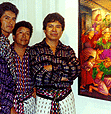 Brothers
Mariano [r.] and Matias Gonzalez Chavajay, and their
cousin Rafael Enrique Gonzalez Mendez stand beside Mariano's most
important painting dealing with the capture of the members of the Death
Squad which operated in San Pedro la Laguna in the first half of the
1980's. Mariano and Matias along with Pedro Rafael Gonzalez Chavajay are
San Pedro's most famous painters. Brothers
Mariano [r.] and Matias Gonzalez Chavajay, and their
cousin Rafael Enrique Gonzalez Mendez stand beside Mariano's most
important painting dealing with the capture of the members of the Death
Squad which operated in San Pedro la Laguna in the first half of the
1980's. Mariano and Matias along with Pedro Rafael Gonzalez Chavajay are
San Pedro's most famous painters. |
|
| . | |
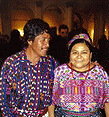 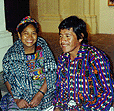 Emilio
Gonzalez Morales is the most well known of three brothers who paint. He is
photographed here with Nobel Peace prize winner Rigoberta Menchú and with
the first Mayan woman representive in Guatemala's congress. Emilio
Gonzalez Morales is the most well known of three brothers who paint. He is
photographed here with Nobel Peace prize winner Rigoberta Menchú and with
the first Mayan woman representive in Guatemala's congress. |
|
 Emilio's
older brother Juan Fermin Gonzalez had an inspiration, possibly as a
result of being a helicopter pilot during his service in the military, to
paint scenes from the point of view of a bird looking
straight down upon them. A painting by San Pedro artist Abraham Batzin
adopting Juan Fermin's idea won first place in Guatemala's most important
art competition, the Paiz Biennial. Emilio's
older brother Juan Fermin Gonzalez had an inspiration, possibly as a
result of being a helicopter pilot during his service in the military, to
paint scenes from the point of view of a bird looking
straight down upon them. A painting by San Pedro artist Abraham Batzin
adopting Juan Fermin's idea won first place in Guatemala's most important
art competition, the Paiz Biennial. |
|
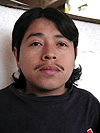 Lorenzo
Gonzalez Morales is the youngest of the three brothers, and prefers
painting with watercolor and goaches than oil paints. Lorenzo
Gonzalez Morales is the youngest of the three brothers, and prefers
painting with watercolor and goaches than oil paints. |
|
| . | |
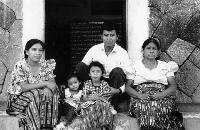 Chema Cox and his wife are both schoolteachers. Chema's
specialty is watercolors. Chema began as a "primitivist", but began to be
interested in more traditional styles of painting. He soon began to specialize in
watercolors. He and a young nephew paint contemporary Mayan subjects. He
traveled to
Spain for an exhibition of his paintings in November of 1995. Chema Cox and his wife are both schoolteachers. Chema's
specialty is watercolors. Chema began as a "primitivist", but began to be
interested in more traditional styles of painting. He soon began to specialize in
watercolors. He and a young nephew paint contemporary Mayan subjects. He
traveled to
Spain for an exhibition of his paintings in November of 1995. |
|
| . | |
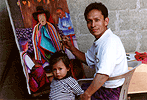 When I met Domingo Garcia in 1988 there were only a handful
of painters in San Pedro. Domingo had not been painting for several years, but the few
paintings he still had made me insist that he continue. I bought him the brushes he
needed, and he has earned his living painting ever since. A few years
later he returned the favor giving me one of his
best early paintings. While clearly painting in the Tz'utuhil style Domingo
has quietly forged his own path. Unlike the majority of other artists who
set their paintings in the tourist towns of Santiago Atitlán and
Chichicastenago, Domingo almost always uses the traje of San Pedro. When I met Domingo Garcia in 1988 there were only a handful
of painters in San Pedro. Domingo had not been painting for several years, but the few
paintings he still had made me insist that he continue. I bought him the brushes he
needed, and he has earned his living painting ever since. A few years
later he returned the favor giving me one of his
best early paintings. While clearly painting in the Tz'utuhil style Domingo
has quietly forged his own path. Unlike the majority of other artists who
set their paintings in the tourist towns of Santiago Atitlán and
Chichicastenago, Domingo almost always uses the traje of San Pedro. |
|
| . | |
|
|
| . | |
| . |
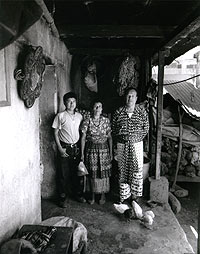 Lorenzo Gonzalez Chavajay with one of
his daughters, and a young nephew who he was teaching to paint.
Lorenzo finished just one
more painting after this photo was taken before he died. His style of painting was the most naive of
any of the painters, but at the same time he has the most affinity for
modern design. Lorenzo touches many people deeply because his paintings
simply express the varied experiences of his life. Lorenzo Gonzalez Chavajay with one of
his daughters, and a young nephew who he was teaching to paint.
Lorenzo finished just one
more painting after this photo was taken before he died. His style of painting was the most naive of
any of the painters, but at the same time he has the most affinity for
modern design. Lorenzo touches many people deeply because his paintings
simply express the varied experiences of his life. |
| . | |
| . |
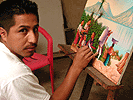 Miguel
Sunu appreticed himself to Pedro Rafael Gonzalez Chavajay. His figures
resemble those of his teacher, but his colors are distinctively his own.
Like Pedro Rafael he paints very slowly focusing on quality, but like a
number of young artists he is finishing his education so he won't
necessarily need to be dependent on painting as his primary source of
income. Miguel
Sunu appreticed himself to Pedro Rafael Gonzalez Chavajay. His figures
resemble those of his teacher, but his colors are distinctively his own.
Like Pedro Rafael he paints very slowly focusing on quality, but like a
number of young artists he is finishing his education so he won't
necessarily need to be dependent on painting as his primary source of
income. |
| . | |
|
|
|
| . | |
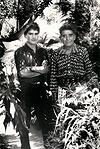 Juan Gonzalez Chavajay with his father in their Garden. Juan
has one of the few gardens in the center of San Pedro which still open to the street. He
keeps it filled with beautiful and exotic flowers. Juan's older brother, a poet, inspired
him to become a painter. Juan's brother was killed by the death squads, probably because
of his outspoken pacifist views. Juan Gonzalez Chavajay with his father in their Garden. Juan
has one of the few gardens in the center of San Pedro which still open to the street. He
keeps it filled with beautiful and exotic flowers. Juan's older brother, a poet, inspired
him to become a painter. Juan's brother was killed by the death squads, probably because
of his outspoken pacifist views. |
|
| . | |
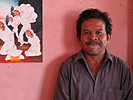 In 1988 Antonio took up painting to occupy his mind after his oldest son was
killed by a car while crossing a street in Guatemala City. Painted more as
therapy to get his mind off his son his first paintings were perhaps his
most original. The market dictated that if he wanted to make In 1988 Antonio took up painting to occupy his mind after his oldest son was
killed by a car while crossing a street in Guatemala City. Painted more as
therapy to get his mind off his son his first paintings were perhaps his
most original. The market dictated that if he wanted to make money he should paint quickly. He complied but decided to use bright
colors. Antonio now paints mainly for the galleries in Santiago Atitlán
and although he paints occasional large works he mainly produces hundreds
of small paintings for tourists. Below Antonio Chavajay Yojcom works on a painting while his young
son watches.
money he should paint quickly. He complied but decided to use bright
colors. Antonio now paints mainly for the galleries in Santiago Atitlán
and although he paints occasional large works he mainly produces hundreds
of small paintings for tourists. Below Antonio Chavajay Yojcom works on a painting while his young
son watches. |
|
| . |
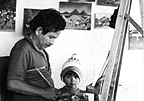 |
| . | |
 Pascual
Pur Gonzalez took up painting after his younger brother Jose Antonio Pur
Gonzalez learned to paint by apprenticing himself to Mariano Gonzalez
Chavajay. Pascual
Pur Gonzalez took up painting after his younger brother Jose Antonio Pur
Gonzalez learned to paint by apprenticing himself to Mariano Gonzalez
Chavajay. |
|
| . | |
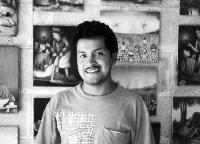 Diego Puzul tends his father's art gallery in San Pedro la
Laguna. They have recently built a new larger one with plently of light. Diego Puzul tends his father's art gallery in San Pedro la
Laguna. They have recently built a new larger one with plently of light. |
|
| . | |
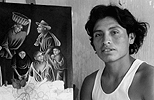 Bartolo
Quiacain Cruz, a promising young painter, studied with Pedro Rafael
Gonzalez Chavajay for more than a year. He then began working on his own
but failed to make money enough money to justify his working full time on
it. He gave up painting when his father started a bus service between San
Pedro and Guatemala City. Bartolo
Quiacain Cruz, a promising young painter, studied with Pedro Rafael
Gonzalez Chavajay for more than a year. He then began working on his own
but failed to make money enough money to justify his working full time on
it. He gave up painting when his father started a bus service between San
Pedro and Guatemala City. |
|
| . | |
| LINKS TO SECTION PAGES |
|
| . | |
|
|
To contact us write: Arte Maya Tz'utuhil, P.O. Box 40391, San
Francisco, CA 94140. Telephone: (415) 282-7654.
Email me at
All paintings and photographs Copyright © 1988–2015 Arte Maya Tz'utuhil |

